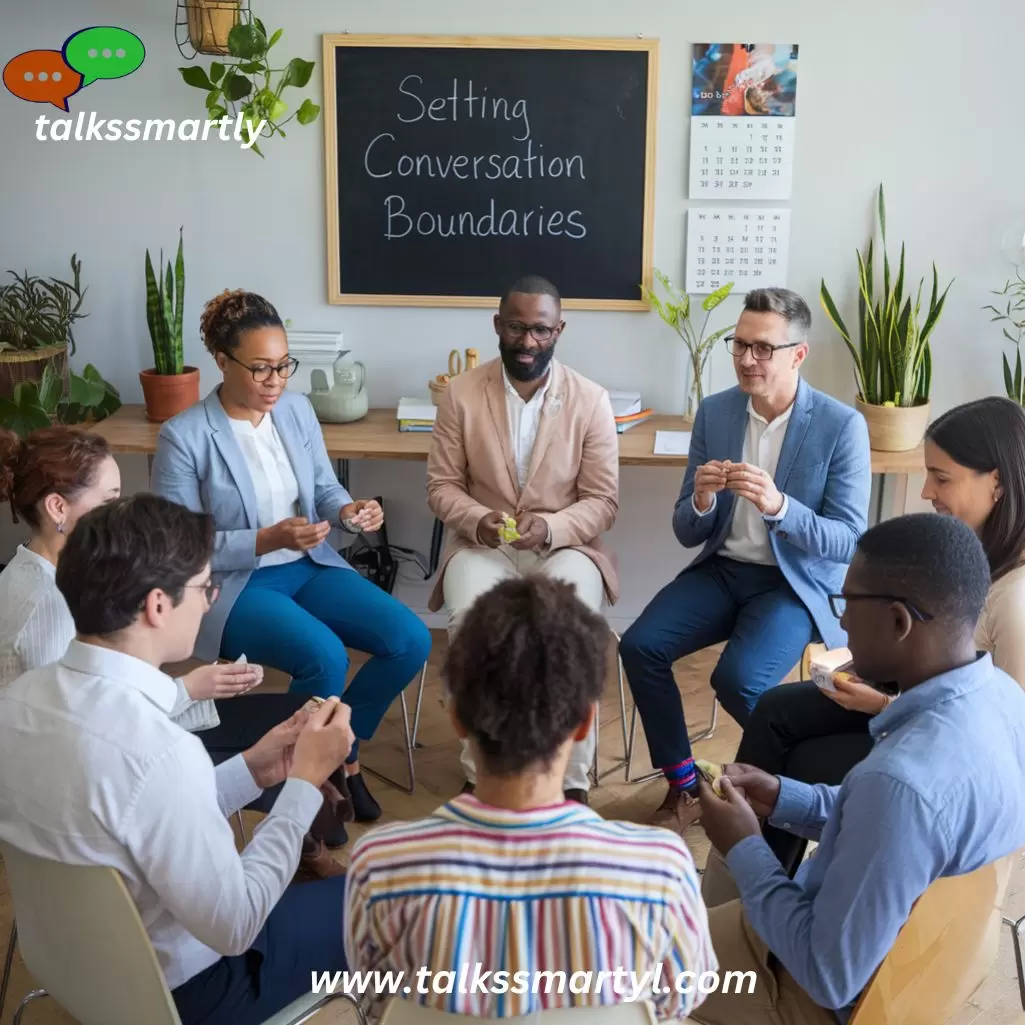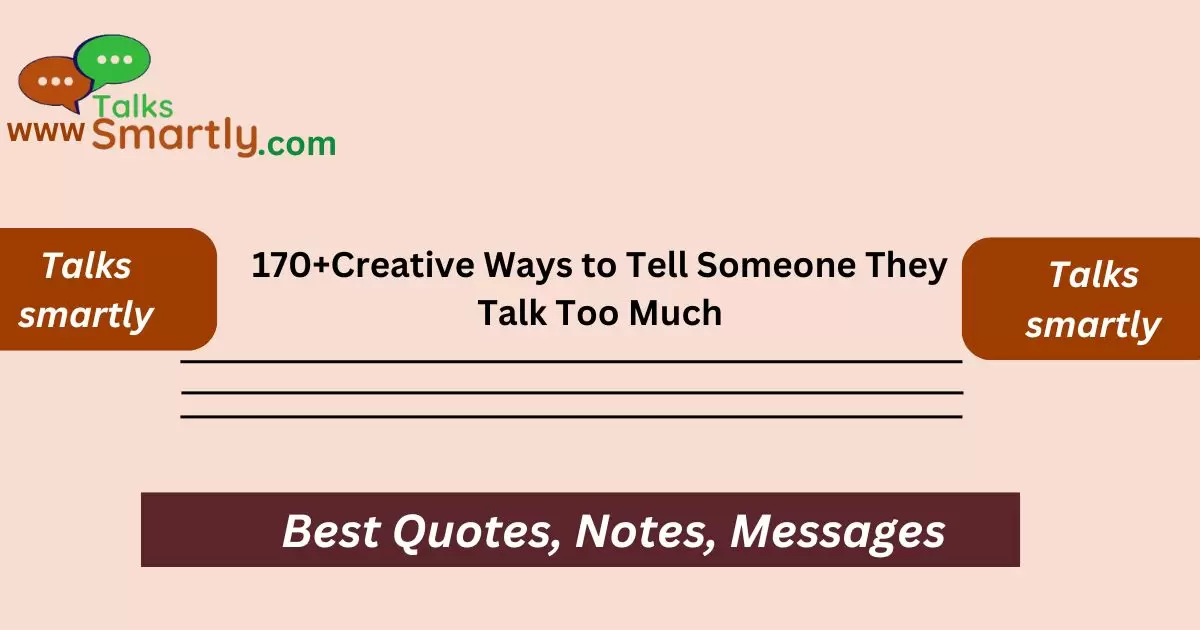“Ever find yourself trapped in a conversation where the other person just doesn’t stop talking? Here are some creative ways to gently let someone know they might be oversharing.”
Having a conversation with someone who talks too much can be overwhelming. It’s a delicate situation that requires a balance between honesty and tact. You don’t want to hurt their feelings, but you also need to address the issue so you can enjoy more balanced conversations.
If you’re looking for a polite yet effective way to hint that they may be talking too much, you’re in the right place. These creative approaches will help you communicate your message without causing offense. Use these strategies to maintain good relationships while keeping conversations enjoyable and engaging.
Let’s explore some inventive methods to let someone know they might be dominating the conversation more than necessary. These techniques can help you steer the dialogue back to a more comfortable and reciprocal exchange.
1. Direct but Polite Approaches
- “I’d love to hear everyone’s thoughts on this too.”
- “Let’s make sure we’re giving everyone a chance to speak.”
- “I’m finding it a bit hard to keep up with everything you’re saying.”
- “Can we circle back to this topic after hearing from others?”
- “I appreciate your enthusiasm; let’s hear from some others now.”
- “I’m interested in what others have to say about this.”
- “Let’s take a quick pause and see if anyone else wants to add something.”
- “I’m enjoying this topic, but I’d also like to hear different perspectives.”
- “Let’s balance the conversation a bit so we can hear from everyone.”
- “I think we’ve covered this well; let’s move on to other topics.”
- “It’s great you have so much to share; let’s get some other input too.”
- “How about we let someone else take the floor for a moment?”
- “I’m sure everyone has something to contribute here.”
- “Could we give others a bit of time to share their thoughts?”
- “Let’s shift gears and let others join in the discussion.”
2. Humorous Approaches

- “I think you might have just set a record for longest monologue!”
- “If talking were an Olympic sport, you’d be a gold medalist!”
- “Are you preparing for a speech contest or just sharing?”
- “I didn’t realize I signed up for a lecture series today!”
- “I think you might be on your way to breaking the Guinness World Record for talking.”
- “Wow, I didn’t know we were hosting a talk show!”
- “You must have been practicing for a TED Talk!”
- “Do you have a timer set for this conversation?”
- “Is there a prize for talking non-stop?”
- “I think you’ve just invented a new type of marathon—talking!”
- “I feel like I need a break just listening to you.”
- “You’ve certainly given us a lot to think about!”
- “I’m going to need a notepad to keep track of all the points you’ve made!”
- “You should start a podcast—this is impressive!”
- “I didn’t expect a lecture on this topic, but it’s been quite enlightening.”
3. Use of Body Language
- “Start looking around the room as if inviting others to speak.”
- “Maintain eye contact with others to encourage them to jump in.”
- “Use hand gestures to subtly suggest switching topics.”
- “Nod and smile while subtly shifting your body away to signal a change.”
- “Position yourself so you’re facing different people to promote inclusivity.”
- “Glance at your watch or phone to hint at the need to wrap up.”
- “Open up the conversation circle by turning slightly towards others.”
- “Adjust your posture to show readiness for someone else to speak.”
- “Tap your pen or take notes to shift the focus from the speaker.”
- “Show interest in others’ reactions to encourage them to speak.”
- “Physically lean back to suggest a pause in the monologue.”
- “Tilt your head or look inquisitively at others to prompt their input.”
- “Use non-verbal cues to signal that a change in speaker is needed.”
- “Hold up your hand as if making a point to invite others in.”
- “Shift your gaze frequently to suggest a broader conversation.”
4. Creative Conversation Redirects
- “Let’s switch topics to something everyone is passionate about.”
- “How about we share our favorite experiences related to this?”
- “What are your thoughts on a new topic that interests us all?”
- “Let’s brainstorm some ideas together.”
- “Can we each share one thought on this and then move forward?”
- “I’d love to hear your stories, but let’s explore a new subject now.”
- “How about we each take turns giving our input on this?”
- “Let’s make this a roundtable discussion.”
- “What’s everyone’s take on this topic?”
- “Can we switch gears and discuss something fresh?”
- “I’d like to hear from others about their related experiences.”
- “Let’s focus on a new angle or aspect of this subject.”
- “How about we take a quick break and discuss something else?”
- “What’s another related topic we could dive into?”
- “Let’s explore a different perspective on this issue.”
5. Encouraging Others to Speak
- “Let’s hear what everyone else thinks about this.”
- “What do you think about this, [Name]?”
- “I’m curious to know how others feel about this topic.”
- “Can we get some feedback from others in the group?”
- “What’s your take on this, [Name]?”
- “Let’s open the floor for others to contribute.”
- “I’m interested in hearing [Name]’s perspective on this.”
- “How does everyone else view this situation?”
- “Let’s hear some different viewpoints on this.”
- “What are your thoughts, [Name]?”
- “I’d love to hear from others who haven’t spoken yet.”
- “Can we get some additional opinions on this?”
- “How about we hear from someone else in the group?”
- “I’m excited to learn what others think about this topic.”
- “Let’s invite others to share their thoughts too.”
6. Subtle Hints
- “I’m sure we’ve all got something to add here.”
- “This has been fascinating; let’s hear from others as well.”
- “I think we’ve explored this topic well; time to move on.”
- “It’s interesting to hear your view; let’s expand the discussion.”
- “I’d like to hear from others about their experiences too.”
- “We’ve gotten a lot of input; let’s see what others have to say.”
- “This is a great topic; let’s get other opinions too.”
- “I’m interested in everyone’s thoughts, not just one.”
- “Let’s broaden this conversation to include others.”
- “We should make sure everyone gets a chance to speak.”
- “I’d love to hear different perspectives on this.”
- “Let’s open this up for more input from the group.”
- “This topic is so engaging; let’s see what others think.”
- “I’m sure others have valuable input on this as well.”
- “Let’s keep the conversation flowing by hearing from more people.”
Responses to Use When You Receive a Text from an Unknown Number
7. Playful Teasing
- “Are you auditioning for a role as a human radio?”
- “I didn’t realize we were having a monologue contest!”
- “Is this your way of becoming a conversation champion?”
- “Are you preparing for a storytelling marathon?”
- “Is there a secret you’re revealing in every sentence?”
- “Do you have a script you’re working from?”
- “Are you trying to win an award for most words spoken?”
- “I didn’t know you were practicing for a speech competition!”
- “Are you working on your next big talk show?”
- “Is this your attempt at becoming the life of the party?”
- “Are you rehearsing for a motivational speaker gig?”
- “Do you have a record you’re trying to break?”
- “Is this your way of showcasing your oratory skills?”
- “Are you giving a lecture or just sharing your thoughts?”
- “Is this your personal podcast episode?”
8. Using Humor and Jokes
- “I think we need a pause button for this conversation!”
- “I didn’t realize I was joining a TED Talk today!”
- “Is there a break time scheduled for this chat?”
- “I think we might need a time limit on this topic!”
- “If talking were a marathon, you’d be finishing first!”
- “I feel like I’ve been enrolled in a speech class!”
- “Are we setting a world record for talking today?”
- “Is this conversation on an infinite loop?”
- “Do we have a timer for this chat or is it non-stop?”
- “I think we might need a translator for all this talk!”
- “I didn’t realize I signed up for a lecture series!”
- “Is this a never-ending story or just a long chat?”
- “Are we discussing this topic in every possible detail?”
- “Do you have a book or a script you’re reading from?”
- “Is this a one-person show or can others join in?”
9. Expressing Interest in Other Topics
- “What do you think about discussing something different?”
- “Let’s explore a new subject; this has been interesting!”
- “How about we switch to another topic that interests us all?”
- “I’m curious about your thoughts on a different matter.”
- “Can we pivot to another subject that’s on everyone’s mind?”
- “Let’s dive into a new area of discussion.”
- “I’d love to hear about your thoughts on a fresh topic.”
- “How about we transition to something new and exciting?”
- “Can we change gears and discuss another interest?”
- “Let’s move to a different subject to keep things lively.”
- “I’m eager to hear what others think about a new topic.”
- “What’s another area we could explore together?”
- “Can we shift to another topic that sparks interest?”
- “Let’s try a new discussion topic for variety.”
- “I’m interested in hearing about something different now.”
10. Positive Reinforcement with a Suggestion
- “I love your enthusiasm; let’s also hear from others.”
- “Your insights are great; let’s make room for more voices.”
- “This topic is fascinating; let’s balance it with other opinions.”
- “You’ve shared a lot; let’s give others a chance to contribute.”
- “Your points are valuable; let’s see what others think as well.”
- “I appreciate your input; let’s open the floor to others.”
- “You’ve made some great points; let’s get additional perspectives.”
- “I’m enjoying this; let’s expand the conversation to include others.”
- “Your thoughts are interesting; let’s hear from the group too.”
- “I value your perspective; let’s invite more voices into the discussion.”
- “Your input is insightful; let’s see what others have to share.”
- “I’m grateful for your contributions; let’s balance the conversation.”
- “You’ve been informative; let’s get some feedback from others.”
- “Your enthusiasm is noted; let’s include others in this chat.”
- “You’ve given us much to think about; let’s hear from others now.”
11. Setting Conversation Boundaries

- “Let’s keep our discussions brief to include more topics.”
- “Can we aim for shorter turns so everyone gets a chance?”
- “Let’s set a time limit for each topic to keep things moving.”
- “I suggest we keep our points concise to involve everyone.”
- “To keep the discussion lively, let’s keep each input short.”
- “How about we limit each person to a few minutes to speak?”
- “Let’s agree on a time frame for each topic to allow diversity.”
- “To stay engaging, let’s keep our comments brief and varied.”
- “We should try to stay on topic and keep it succinct.”
- “How about a quick round of input from everyone?”
- “Let’s limit our discussion time on each point to be fair.”
- “To keep it interesting, let’s make sure everyone has a turn.”
- “Can we agree on short contributions to keep the flow going?”
- “Let’s set some guidelines for brief and focused discussions.”
- “To include everyone, let’s keep each point short and sweet.”
12. Empathizing and Redirecting
- “I understand you have a lot to share; let’s hear from others too.”
- “I know this topic is important to you; let’s balance it with more voices.”
- “It’s clear you’re passionate; let’s allow others to share their views.”
- “I see you have much to say; let’s make space for others to join in.”
- “I appreciate your detailed input; let’s include other perspectives.”
- “You’ve given us a lot to think about; let’s hear from the group as well.”
- “It’s great you’re so involved; let’s ensure everyone gets a chance to speak.”
- “I value your input; let’s give others an opportunity to contribute.”
- “You’ve made some strong points; let’s open the discussion to everyone.”
- “I get that this is a key topic; let’s hear from others about their thoughts.”
- “You’ve been very thorough; let’s also get feedback from others.”
- “I understand your passion; let’s make sure we involve more voices.”
- “Your insights are valuable; let’s ensure a balanced conversation.”
- “It’s clear you have a lot to offer; let’s bring others into the dialogue.”
- “I appreciate your thoroughness; let’s expand the conversation to others.”
Conclusion
Navigating conversations with someone who talks too much requires a mix of tact and creativity. By employing these creative methods, you can gently steer the conversation towards a more balanced exchange without causing offense. The key is to remain respectful and considerate while addressing the issue.
These strategies offer a variety of ways to manage conversations effectively and ensure everyone has a chance to participate. Remember, the goal is to foster engaging and enjoyable discussions while maintaining harmony in your relationships.
Answer to key Question
- What are some subtle ways to let someone know they talk too much?
- Use body language cues like looking around the room or nodding towards others.
- Redirect the conversation by introducing new topics or asking for others’ opinions.
- Make light-hearted comments about needing a break or changing topics.
- Encourage group discussions to include multiple perspectives.
- Offer gentle reminders about balancing the conversation.
- How can I address someone who dominates the conversation without offending them?
- Be polite and respectful in your approach.
- Use humor to lighten the mood and avoid sounding confrontational.
- Redirect the conversation gently towards other participants.
- Acknowledge their contributions while suggesting a shift in focus.
- Maintain a positive tone to ensure your feedback is constructive.
- When is it appropriate to use humor to address someone who talks too much?
- When you have a close relationship with the person and they understand your sense of humor.
- In informal settings where a playful approach won’t be taken the wrong way.
- When you’re sure that humor will not hurt their feelings or create tension.
- In group settings where humor can be used to diffuse the situation and include others.
- When the conversation is light-hearted and the humor is clearly understood.
- What should I do if the person continues to talk excessively despite hints?
- Have a direct but polite conversation about the need for balanced dialogue.
- Express your feelings honestly and suggest ways to improve the conversation dynamic.
- Reinforce the need for everyone to have a chance to speak.
- Offer to schedule one-on-one time to discuss in more detail if needed.
- Remain patient and understanding, and continue to use gentle redirection.
- Can these methods be used in professional settings?
- Yes, but with more caution. Tailor your approach to be more formal and respectful.
- Use subtle hints and professional language to address the issue.
- Ensure that your feedback is constructive and aimed at improving communication.
- Focus on maintaining professionalism while encouraging balanced discussions.
- Be mindful of the context and the impact of your approach on workplace relationships.












